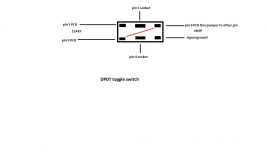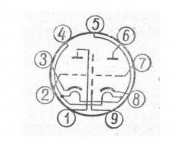Thanks for that. My use case is in an RIAA stage as above.
I noticed some audible difference as I believe cyto mentioned (I didn’t perceive it as good or bad necessarily- was a brief test), and wanted to understand why. I thought either just normal tube variance or my mind was playing tricks / I was victim of my own bias. But there seems to be some differences that have been discussed that could change real operating parameters.
I’m wondering how best to adapt a 12ax7 riaa stage for use with 6N2P.
I noticed some audible difference as I believe cyto mentioned (I didn’t perceive it as good or bad necessarily- was a brief test), and wanted to understand why. I thought either just normal tube variance or my mind was playing tricks / I was victim of my own bias. But there seems to be some differences that have been discussed that could change real operating parameters.
I’m wondering how best to adapt a 12ax7 riaa stage for use with 6N2P.
Last edited:
The answer is different depending on whether you are using passive EQ or EQ in a feedback loop.
For passive you will generally need to compensate for the change in rp unless it is very small and the network is insensitive to small variations in source impedance.
For feedback based EQ the situation will depend on the effect the substitution has on the overall closed loop gain, some minor changes to the design may address or adjustments to the feedback network may be required.
For passive you will generally need to compensate for the change in rp unless it is very small and the network is insensitive to small variations in source impedance.
For feedback based EQ the situation will depend on the effect the substitution has on the overall closed loop gain, some minor changes to the design may address or adjustments to the feedback network may be required.
I have been using 6n2p-ev in my Hagerman Cornet2 phono stage off and on for a few years. I put switches in so I could go back forth between the 6n2p-ev and 12ax7. I tried the adapters but they were noisy, maybe because you can't connect the shield to ground.
I am still working on optimal circuit changes for the 6n2p-ev, but I have to go by my ears.
Hi, I like the idea of being able to simply switch between the 12ax7 or 6N2P-EV
Can you please specify the type of switch and spec that would be suitable and a diagram as to how to wire it?
Will the switch in circuit affect the sound?
Thanks
This is what I did, a quality switch will not affect the sound, it is quieter than using an adapter. The red line is a jumper. Needless to say pins 5 and 9 on the socket must be disconnected from the PCB first.
Do this at your own risk, a wiring mistake could be dangerous. I was a CET and have had training.
Do this at your own risk, a wiring mistake could be dangerous. I was a CET and have had training.
Attachments
The plate resistance of the triode is a variable. Run those preamp tubes at 0.3mA, and then run them at 3mA. What would you like the plate resistance to be?
Tubes are often more linear at higher plate currents. And the plate resistance is lower there.
Tubes are often more linear at lower negative grid bias, and less linear at high negative grid bias. But they are also often less linear nearer to 0V grid bias (even if the signal does not drive the grid positive).
You can run those preamp tubes at 250V and 0.3mA and not even warm the plate. But you will be at a very high negative bias.
You can run those tubes at 250V and 3mA, And still be less than the maximum plate dissipation. But you will be very close to 0V grid bias.
Start with the family of curves, then find a good operating point of plate volts, plate current, and grid bias. The plate voltage might be 100V, 150V, 200V, 250V, you need to determine that. Then measure the plate curve at that operating point, and its slope rp = delta Ep/delta Ip. To determine the plate load, you may also want to decide what B+ you want to use to optimize the plate load for linearity, gain, and required voltage swing. Now you need to pick a plate load resistance (and include the network load too). Draw that load line, and verify that the tube is linear for that operating point, load line, and the input signal maximum + and - excursion. Now, design the RIAA network around that plate resistance, rp, in parallel with the plate load.
Tubes are often more linear at higher plate currents. And the plate resistance is lower there.
Tubes are often more linear at lower negative grid bias, and less linear at high negative grid bias. But they are also often less linear nearer to 0V grid bias (even if the signal does not drive the grid positive).
You can run those preamp tubes at 250V and 0.3mA and not even warm the plate. But you will be at a very high negative bias.
You can run those tubes at 250V and 3mA, And still be less than the maximum plate dissipation. But you will be very close to 0V grid bias.
Start with the family of curves, then find a good operating point of plate volts, plate current, and grid bias. The plate voltage might be 100V, 150V, 200V, 250V, you need to determine that. Then measure the plate curve at that operating point, and its slope rp = delta Ep/delta Ip. To determine the plate load, you may also want to decide what B+ you want to use to optimize the plate load for linearity, gain, and required voltage swing. Now you need to pick a plate load resistance (and include the network load too). Draw that load line, and verify that the tube is linear for that operating point, load line, and the input signal maximum + and - excursion. Now, design the RIAA network around that plate resistance, rp, in parallel with the plate load.
Last edited:
I have replaced all my 12AX7s to 6n3p. I did not like the 12AX7 and it's family to start with, but the 6n3ps blow them out of the water. They make beautiful sounds. I also use the 6SL7s instead of the 12AX7s, but lean heavily upon the Russian 6n2ps. I do not like the tubes that everyone uses, because it is difficult to get a unique sound out of gear the whole world is using. God, I love tubes.
I have a fender DeVille I also have a 65 reissue and a deluxe vintage modified that all takes 12ax7's I was able to get some Russian 6H2N's.. because there is no 12ax7's available.. My question is really simple can I simply remove the 12ax7's and replace it with the 6 h2n without hurting anything in my amp I don't gig I play and record from my home studio and my amplifiers are not usually on longer than just a few hours.....I have replaced all my 12AX7s to 6n3p. I did not like the 12AX7 and it's family to start with, but the 6n3ps blow them out of the water. They make beautiful sounds. I also use the 6SL7s instead of the 12AX7s, but lean heavily upon the Russian 6n2ps. I do not like the tubes that everyone uses, because it is difficult to get a unique sound out of gear the whole world is using. God, I love tubes.
thanks for any help guys
I was able to get some Russian 6H2N's.. because there is no 12ax7's available..
I see lots of 12AX7's in stock at thetubestore.com. They are out of the more popular tubes, but still show stock for many others.
Looks like Jim McShane has 12AX7's listed on his page as well?
jeff
Last edited:
this is 100% untrue, they are in stock at half a dozen vendors at least. I even found some on amazon.because there is no 12ax7's available..
- Home
- Amplifiers
- Tubes / Valves
- 6N2P-EV vs 12AX7

